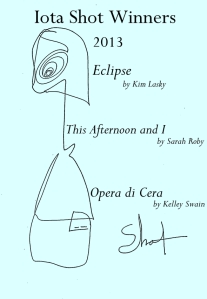
I’m delighted to announce that my verse drama about anatomical wax models has resurrected itself. A selection of 16 poems from the full, unpublished 40-poem verse drama has won the Templar Poetry ‘iOTA Shots’ pamphlet awards for 2013. Opera di Cera will be published and launched at the Derwent Poetry Festival in November of this year.
Particular thanks are due to Dr Anna Maerker, my research advisor on the historical aspects of the project, and Dr Richard Barnett, Sarah Westcott, and Lorraine Mariner for acting as editors for early drafts of the work. I must thank Richard for the title, too, which I think is a vast improvement from my original working title, ‘Venus Heart’. Opera di Cera literally translates as ‘wax work,’ or ‘work of wax,’ and is a fine embodiment of what the poems, written in the voices of five characters, hold in store.
Inspired by the anatomical wax models at La Specola, the Florentine Museum of Physics and Natural History, which opened in 1775, Opera di Cera draws on real historical characters and events, blending fact with Pygmalion myth. The drama focuses on the creation of the ‘Anatomical Venus,’ a famous, life-sized female figure who comes apart (or is ‘dissectible’) to reveal a foetus in the womb. The Venus has received the most attention, historically, of all wax models, for her beauty, her uncanny realism, and the academic feminist debates that tend to rage around her.
Joanna Ebenstein of the Morbid Anatomy blog frequently features the anatomical Venus. Last year, the Last Tuesday Society hosted an exhibition about the Venus, curated by Ebenstein and including pieces by wax modeller Eleanor Crook. In a strange coincidence, I also had the opportunity, in early stages of research, to meet Sarah Simblet, anatomical artist, and hear her story about the influence the Specola waxes had on her as a student.

I spent a year researching Opera di Cera with Anna’s help, basing my initial reading on her book, Model Experts: Wax Anatomies and Enlightenment in Florence and Vienna, 1775 – 1815. Anna kindly gave me her manuscript before the book was even published.
I spent most of my time in the Wellcome Library researching the history of wax models, reading about 18th century recipes for the pigments that tint wax, and digging up graphic descriptions of bodysnatching, abortifacients, and vivisection. The work of present-day wax modeller Eleanor Crook provided an invaluable resource. Much of the poetry was also inspired by the photographic collection of ‘Wax Bodies‘ by Tanya Marcuse.
It’s an honour to become part of the tradition of artistic response that has arisen around the Specola waxworks, and wax models in general. I’m particularly interested in how the artists who respond to the wax models tend to be women.
Taking a unique opportunity to house-and-cat-sit for three months in the South of France last autumn and winter, I wrote an early draft of Opera di Cera and was greatly inspired by the sumptuous markets and sensual landscape of the Côte d’Azur. I rounded off the trip for my birthay in January 2012 with a pilgrimage to Florence, to La Specola itself, going there more than once, spending time with the real waxworks and the real Venus. The waxworks are on display today much as they were in the late 1700s, the time in which I set the verse drama.
It is extremely encouraging to be one of the three winners of this year’s Templar iOTA Shots poetry awards. The fact that an excerpt from a verse drama about 18th-century anatomical wax models can win an anonymous poetry prize reinforces my belief in the work, and in my general ambitions for ‘science poetry’!
